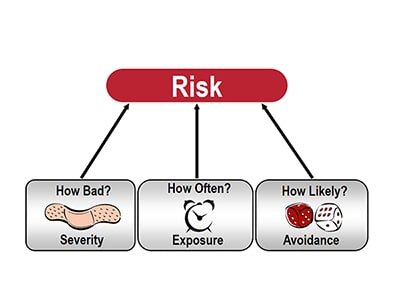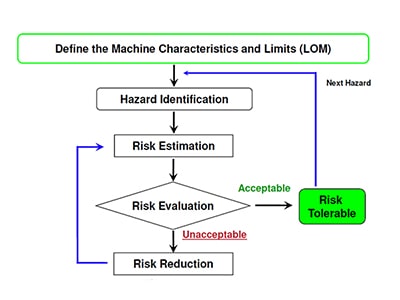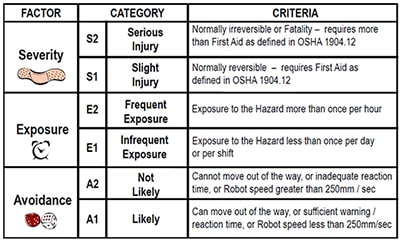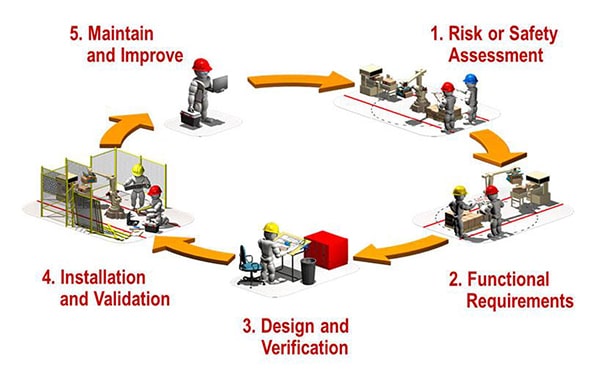
Blog > Automation > 5 Machine Safety FAQs Answered
5 Machine Safety FAQs Answered
12/15/16 | Tom Hopkins, Rexel Technical Consultant

Blog > Automation > 5 Machine Safety FAQs Answered
12/15/16 | Tom Hopkins, Rexel Technical Consultant
This is part one of a two-part series. Don’t miss part two: 5 Safety Control System FAQs Answered.
Terms like “Functional Safety” and “Risk Assessment” can be intimidating. Machine safety does not have to be a daunting and unapproachable topic, and your plant’s safety does not have to come at the expense of productivity. In this post, we’ll address the following FAQs regarding this topic:
If any of those questions sound unfamiliar, that’s okay. We’ll focus on the important concepts of functional safety and answering those questions. In the past, some folks considered the term “safety” as a barrier or as extra work. Keep this in mind: Companies with well-conceived safety systems and cultures are MORE productive than those who think of safety as a restriction.
“Most participating sites report improved employee morale and productivity as a by-product of their safety and health management activities.” Occupational Safety and Health Administration (OSHA)
Actually, this is easier than most think. OSHA lays out very specific guidelines. Many companies use the OSHA guidelines as a starting point when creating their own internal machine safety documents. A good starting point is OSHA Article 5 “General Duty Clause”. This is quite a broad clause, but it states that each employer shall furnish a place of employment free from recognized hazards that are causing or are likely to cause death or serious physical harm to employees. OSHA also has guidelines related to certain types of machinery. For example, OSHA 1910.217 relates to mechanical power presses.

Besides OSHA, there are common safety standards to consider. Two examples would be ISO 13849 for the safety of machinery and IEC 62061 which is often used in the process industry. There is a good amount of overlap between these two standards as they use a similar methodology, and there is talk of ‘harmonizing’ them in the future. Below are a couple of other foundational standards that relate to machine safety, and you may wish to familiarize yourself with them.
Before we define functional safety as a term, let’s discuss the underlying concepts. The key part of the term “functional safety” is functional. What that means is: yes, you can put fencing and hard guards around a machine and lock-out systems to the Nth degree; making it so secure that no one can touch the machine. But workers will still need access to the machine to load or unload. Maintenance workers will need to be able to clean and repair the machine without risk of injury. Functional safety is using intelligent controls to allow normal operation while minimizing risk as close to zero as possible.
Functional safety can be attained with intelligent controls such as light curtains, door interlocks, zone scanners, pressure mats and more. However, these devices are only devices, and you will need to consider the human factor in your planning and documentation. Safety measures are only as good as the culture around them; if the culture around safety is counterproductive, you may be shoveling against the tide.
As I said before, it is proven that companies with well thought out safety systems tend to have lower injury rates and associated costs, as well as being more productive.

The foundation of making a machine safer is to perform a risk assessment. This is a logical, step by step process of determining what you are dealing with; breaking out all the individual hazards to deal with them one at a time. We have resources to help you at this stage of your process. Tools like checklists and audit forms already exist to help jump-start your efforts. The “Fundamental Process” flow chart pictured to the above shows the steps and stages of risk assessment and reduction.
Table 1 – “Risk Estimation Definitions” pictured below, illustrates terminology used in standard RIA 15.06 to help you and your team start moving from an unknown into quantifiable factors and categories. But who decides what is considered “acceptable risk” or not? The standards will help guide you, but there is always a certain level of subjectivity.
Table 1

It is best to have a team approach to come to a consensus. A great step is to form a safety committee of all the people who interact with the machine in ALL its modes of operation. This will very likely include operations and maintenance personnel, but you may also want to consider engineering, safety manager, the cleaning crew and more. Many times, when accidents occur with a machine it is related to someone other than the normal day-to-day machine user or operator.
Let’s assume you have formed a safety committee. Let’s say you are ready to start your first actual risk assessment. Here is what would typically be involved:
ANSI RIA R15.06 has a nice way of quantifying risks. Table 2 – “Initial Risk Rating Table” is pictured below and can be helpful in your process. Risks above a certain “risk reduction category” should be mitigated.
Table 2

Typically, step 4 is where most of the actual brainstorming happens and where most of the work gets done. Can you design out the hazard, guard against it, or must you use electrical controls to mitigate it? What type of circuit architecture and controls are needed? There could be a whole separate post just on this step. In fact, stay tuned to this space for part 2 of this post, all about applied ways to improve machine safety. As you learn more and research more about machine safety and functional safety, you may encounter terms like “Cat 3” and “Cat 4,” or “performance levels.” These terms will also be touched on in part two of this post. If you have an immediate safety application, you can always contact us, and we can help answer your questions.
It is always tough to go at it alone. Find others in your organization who are committed to safety and involve them, either as a formal member of your safety committee or as a sounding board for improvements. It takes many people to drive a culture of safety in any organization.
Document what you are doing. If your safety efforts get put on the back burner, a shared drive with documents on it will make restarting the task easier and quicker. Of course, the documentation isn’t just for the sake of doing so. It will certainly make any future visits from OSHA more organized and professional.

As you make improvements and upgrades, consider if any new elements or processes add new risk. You may need to adjust your controls accordingly. For more web-based information on machine safety, go to www.machinesafetysolutions.com this link will take you to many additional useful resources. You can also contact a Safety Specialist.
Images in this post are © Rockwell Automation®